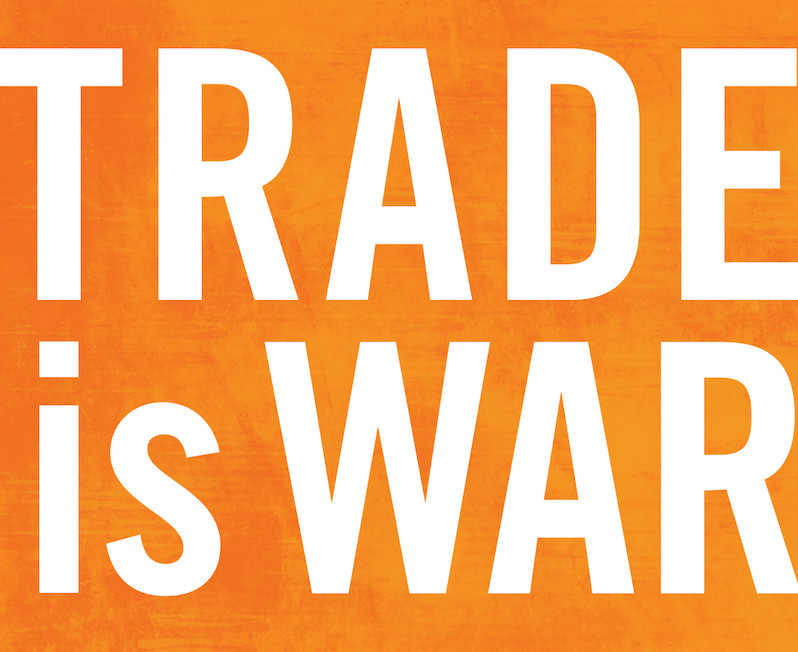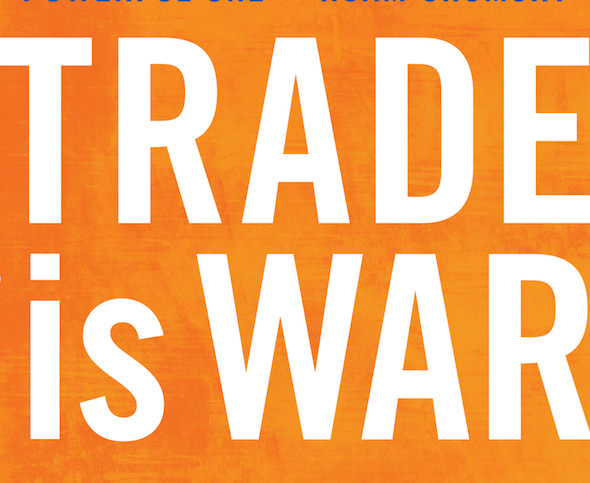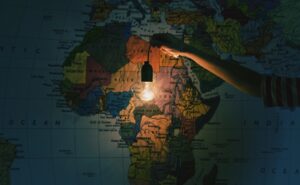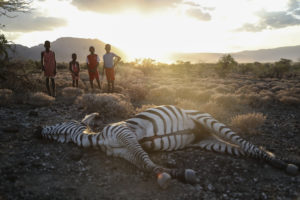An Exclusive Excerpt From ‘Trade Is War’
In his new book, subtitled "The West's War Against the World," international trade expert Yash Tandon challenges the notion that free trade helps countries develop. Instead, he finds, it often fosters poverty and violence.

OR Books
Below is an exclusive excerpt from ‘Trade Is War: The West’s War Against the World’ by Yash Tandon (OR Books, 2015).
|
Truthdig readers receive a 20 percent if they enter the code TRUTHDIG20 at checkout. Click here to buy. |
In the book, Tandon — a Ugandan expert on international relations, politics and economics — argues that the “soft power” exerted by international powers through economic channels is anything but soft — and that free trade (or the refusal to adopt free trade policies) leads to physical violence, especially for poorer countries. To make his case, Tandon draws on both his extensive understanding of the Global South and his hands-on experience advising African leaders on trade agreements.
Here, Tandon describes how nongovernmental organizations and big agricultural corporations team up to override local agricultural custom, often at the expense of farmers:
A Hybrid Seed is Technology
There is one thing about seeds that is not so easy to grasp: a hybrid seed is technology.
I never fully understood this until I was doing research on maize in the Moshi-Arusha region whilst teaching at the University of Dar es Salaam in the 1970s. In 1975 Tanzania faced serious food shortages. Some observers blamed Nyerere’s forced villagization program for the food shortages. But the experts I consulted during my research told me that there were two main reasons: one was the severe drought during the 1973–75 seasons, and the second was that Tanzania was using low-yielding local seeds. Until then most farmers used seeds saved from the previous year’s harvest, but some middle-sized farms also used the improved open-pollinated varieties (OPVs) that were locally developed. They said that Tanzania needed to shift from local maize to hybrids.
Some fifteen years later, in 1990, I visited the region. Most small farmers still used their local varieties. They could not afford to buy the hybrids. Some also used the hybrid CG4141 seeds. After market liberalization, foreign companies had come in to market their seeds. CG4141, marketed by Cargill (a global conglomerate), competed aggressively with the locally bred cultivars multiplied and sold by Tanseed (Tanzania Seed Company). CG4141 seed is ‘improved’ technology. I was told that the famers preferred CG4141 because of its higher yield, except that it was expensive, needed more water and fertilizers, and did not store as well as their old seeds. Also, the ugali (pounded maize cooked into dough) made from it was not as sweet as the old maize. But Tanseed did not have the financial muscle of Cargill. Cargill was winning, but the farmers were going into debt. CG4141 had embedded intellectual property rights owned by Cargill. Cargill extracted hefty royalties for the use of its seeds.
Traditional Knowledge: is it Superior to Modern Knowledge?
I also visited two villages in southwestern Tanzania—Ukwile and Msia. At both villages people were engaged in Low External Input Agriculture (LEIA)—agricultural practices aimed at maximizing the use of local knowledge and resources, and minimizing the use of external inputs. People were experimenting with the use of utupa (Trifosea Vogelli)—a local tree known to the people as a pesticide for controlling pests in maize production and storage. People in the area have traditionally used leaves from this tree and made them into a liquid solution for application to the crops. The people were experimenting with converting the leaves into a powder form, since it is easier to store the pesticides in dust form. They also planted acacia albida (a local tree) and sun hemp to fix nitrogen in the soil, and they planted indigenous varieties of trees and bushes (e.g. nzigati). The traditional knowledge of these was dying out.
Local nganga67 [See footnotes at end] and older people were consulted to identify these trees, and knowledge was resurrected for growing and duplicating these indigenous varieties. I attended one of their workshops where the nganga were telling the poor peasants to value their traditional knowledge. The following is an account from my notes taken at the workshop. ‘Agriculture,’ the nganga argued, ‘is not just about obtaining high yields. It is also about conserving the soil. Soil consists of two distinct layers: topsoil humus that supports microbes and higher plant and animal life, and a surface layer of almost lifeless bedrock.’ The peasants nodded in agreement, they knew all this already. ‘But what is wrong with applying fertilizers to the soil?’ they asked. ‘Fertilizers,’ the nganga explained, ‘cause microbes to grow. These microbes feed on humus, breaking it down faster than otherwise, thus enabling the crops to grow faster also.’ A villager got up and asked, ‘What’s wrong with that?’ The nganga explains, ‘With no humus to hold the soil, it gets washed away, and you have to use more and more fertilizers to give the soil artificial nutrients, and the cycle continues. The energy cost of a unit of food thus goes up. Yes, you get more yields per acre of land, but more and more of it goes to the companies to pay for the fertilizers. So you may grow more and earn less. You are now working for the corporations. That is the immediate effect. But the more important long-term effect is that you have lost control over your soil. The land may belong to you, but that soil is no longer yours.’ I listened in wonderment at the knowledge of the nganga. But the nganga were not having an easy time. Arrayed against them were three forces. One consisted of EU-funded NGOs such as Global 2000, which were distributing fertilizers free of charge to the farmers. Secondly, there was pressure from the better-off ‘progressive’ farmers who were boasting of their ‘high yields’ using hybrids. And third, there was pressure from state agricultural experts, who preached the value of High External Input Agriculture (HEIA). The nganga needed time to show the results of LEIA, but people were told that there was no time: ‘development’ means high yields and fast results. It seemed to me that they were in a hurry, as if to catch a train to some urgent destination. In actual fact, these were ‘negative’ forces at work, which found the ‘alternative’ model of development a threat to their interests.
It is a battle. The corporations play out their macabre war dance on the soil of Africa. They are aided by state agents and Western donor agencies pushing fertilizers and pesticides on the people to ‘hurry, hurry, hurry’ to some dubious destination called ‘growth,’ and the ordinary people (the more enlightened among them) urge the rest to pause and reflect on what they are doing and where they thought they were going.
Monsanto
The most attractive aspect of hybrids is their high yields. Their most destructive aspect is that they wipe out poor farmers who cannot afford the high cost of their production. Seed is only part of a bigger picture. It has to do with the control of not only food production but also of fertilizers, pesticides, herbicides, tube wells and mechanical agricultural tools such as tractors and combine harvesters. So, really, it is a veritable condition of war between big capital on one side and poor farmers on the other.68 So on one side are millions of poor farmers and on the other is a highly concentrated group of global corporations that control genetically engineered seeds and chemicals. The biggest one is Monsanto. It did not start as a seed producer; it started out as a chemical company, and as the following diagram shows, it has ‘cross-licensing’ agreements with a number of chemical companies that produce various kinds of toxins (poisons).
In 2005 Monsanto filed a patent application for breeding techniques for pigs. This was contested by Greenpeace, who argued that Monsanto was trying to claim ownership on ordinary breeding techniques. In February 2012, two NGOs—Navdanya and No Patent on Seeds—filed a complaint against Monsanto claiming that virus-resistant melons were pirated by Monsanto from India. I realize that there are always two sides to a story, and Monsanto and its well-paid lawyers have their own narrative. All the same, the above is enough to illustrate the ongoing battles between what is owned by the people (pig-rearing techniques in Europe and melons in India), and the appropriation of this pre-existing knowledge by the likes of Monsanto. The story does not end here. On 25 May 2013, there were worldwide protests against Monsanto in 436 cities and fifty-two countries. The Associated Press estimated that there were two million protestors.69 In an earlier chapter on the WTO, we saw that the EU and the US spend billions every year on agricultural subsidies to support their farmers. If you think about it, it is clear that these subsidies actually go to enrich the Monsantos of this world that produce seed, fertilizers, and agricultural machinery. I also recounted the story of millions of cotton farmers in the four African states of Benin, Burkina Faso, Chad and Mali, who were literally ruined as a direct outcome of US subsidies to its cotton producers. These subsidies eventually go into the coffers of Monsanto, among other large corporations. This is not all. Having acquired patent rights on its seeds, Monsanto then takes ordinary farmers to court for patent infringement. In a report, the Center for Food Safety said that it discovered 142 patent infringement suits against 410 farmers and fifty-six small businesses in more than twenty-seven states as of December 2012. The amount of money pocketed by Monsanto comes to a whopping $23 million. The study was co-authored by the Save our Seeds (SOS) campaign.70 Monsanto had developed what is colloquially known as ‘terminator seeds.’ Once these get into the soil they suicide (self-destroy) so the farmer has to buy new ones the year after.
If this is not war, what is?
— — —
Footnotes
67. ‘Nganga’: A Bantu term for an herbalist or spiritual healer in many African societies and also in many societies of the African diaspora, such as those in Brazil. 68. There is a huge amount of documented evidence to support this. See, for example, George Susan (1976), How the Other Half Dies: The Real Reasons for World Hunger, Penguin; Vandana Shiva (1992), The Violence of the Green Revolution: Ecological Degradation and Political Conflict in Punjab, Zed Press; and Vandana Shiva (2000), Stolen Harvest: The Hijacking of the Global Food Supply, South End Press. 69. Protesters around the World March Against Monsanto,’ USA Today, 26 May 2013. 70. For more information on the Save our Seeds (SOS) campaign, see www.saveourseeds.org/en.html.
Independent journalism is under threat and overshadowed by heavily funded mainstream media.
You can help level the playing field. Become a member.
Your tax-deductible contribution keeps us digging beneath the headlines to give you thought-provoking, investigative reporting and analysis that unearths what's really happening- without compromise.
Give today to support our courageous, independent journalists.






You need to be a supporter to comment.
There are currently no responses to this article.
Be the first to respond.